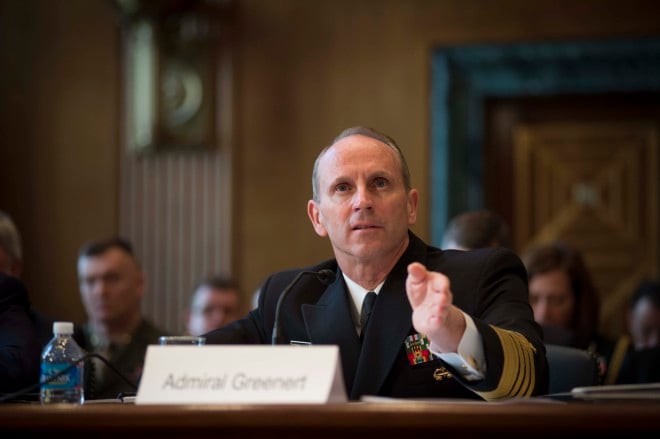
The Chief of Naval Operations said the Ohio-class replacement is his “number one program of concern,” although it remains “on track with all the R&D” to begin construction in 2021, with delivery expected in 2029.
Testifying before the Senate Appropriations Defense Subcommittee on 24 April, Adm. Jonathan Greenert and Navy Secretary Ray Mabus expressed concern about its cost, the impact of sequestration on the program and the impact of building it on the rest of the shipbuilding program.
Mabus said, “Sequestration holds the potential to impact this in a significant way.”
The Navy plans to build 12 of the vessels at a cost of $4.9 billion per submarine and a projected lifecycle sustainment cost of $110 million.
Sen. Jack Reed (D-R.I.) asked whether the Navy was considering seeking funds other than the shipbuilding account to cover the program’s cost; Greenert said it was.
The longer-term impact of continued sequestration on the Navy’s plans to return to a 300-ship fleet by 2019, its aircraft procurement program, and the industrial base came up several times during the abbreviated hearing.
Acknowledging that “we get a big savings with multiyear contracts” for programs such as the DDG-51 and Virginia-class block 4 buys, Mabus said, “sequestration is the culprit” in not meeting bid deadlines in signing contracts with the three shipyards building the vessels. “We’re very cognizant” of the bid deadlines expiring soon on the DDG-51 buy and are working with the shipyards on that contract.
Greenert said he was especially concerned with the impact on the secondary and tertiary suppliers to the larger shipyards and aircraft manufacturers. “We’re very tightly wound with the industrial base.” He added “I’ve taken that shot”—deferring training and documentation in the early stages of shipbuilding—to keep those programs moving along.
Greenert described the delays in delivery of littoral combat ships as “mostly just some hitches when you get a new class of ship.” Mabus said the Navy plans on buying 52 LCSs. “Both versions are performing very well,” he said, as is the Joint High Speed Vessel. For both ships, the Navy is looking to expand their concepts of operations.
While the defense subcommittee plans to hold a separate hearing on the F-35 strike fighter in the future, Sen. Richard Durbin (D-Il.) asked where the program stood in the Navy. Greenert said that although he’s optimistic, tests are only in the beginning stages and work needs to be done on its tailhook and software to make it compatible with other Navy aircraft, such as the F/A-18. The Navy “can’t have [the F-35] as an adjunct.”
To combat sexual assault, Mabus has a response team reporting directly to him and has stepped up training efforts at A School and in the Fleet. “I’m angry about it. It’s an attack on our sailors and Marines . . . and no less than an attack on our integrity.” Marine Corps Commandant Gen. James Otis added, “We are committed to changing the culture . . . from top to bottom” with a comprehensive plan to address sexual assault.
Sen. Durbin and Sen. Barbara Mikulski (D-Md.) told Mabus, Greenert, and Amos, to take a warning back to the Pentagon. “We have been troubled that we have been treated dismissively” when asking about base realignment and closure and other matters in office meetings with defense officials, they said. “We want meetings; we want meetings that matter.”





